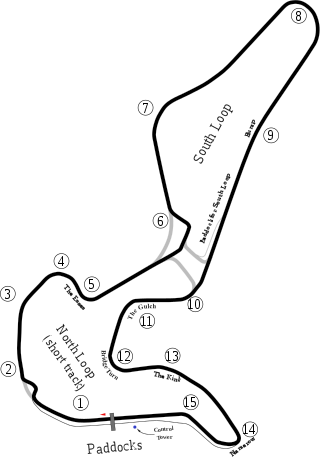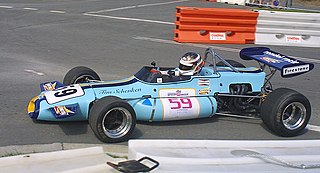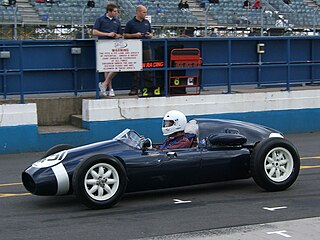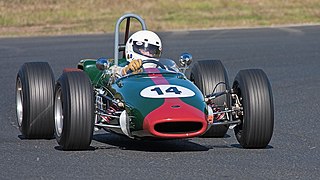Related Research Articles
McLaren Racing Limited is a British motor racing team based at the McLaren Technology Centre in Woking, Surrey, England. The team is a subsidiary of the McLaren Group, which owns a majority of the team. McLaren is best known as a Formula One chassis constructor, the second-oldest active team and the second-most successful Formula One team after Ferrari, having won 186 races, 12 Drivers' Championships, and eight Constructors' Championships. McLaren also has a history in American open wheel racing as both an entrant and a chassis constructor, and has won the Canadian-American Challenge Cup (Can-Am) sports car racing championship.
The Surtees Racing Organisation was a race team that spent nine seasons as a constructor in Formula One, Formula 2, and Formula 5000.
Fittipaldi Automotive, sometimes called Copersucar after its first major sponsor, was a Formula One racing team and constructor that competed from 1975 to 1982. It was the only Formula One team to have been based in Brazil. The team was formed during 1974 by racing driver Wilson Fittipaldi and his younger brother, double world champion Emerson, with money from the Brazilian sugar and alcohol cooperative Copersucar. The team raced under a Brazilian licence. Emerson Fittipaldi became a driver for the team in 1976 after leaving McLaren, but was unable to replicate his earlier success with the family-owned team. Future world champion Keke Rosberg took his first podium finish in Formula One with the team.
Theodore Racing was a Formula One constructor from Hong Kong founded by real estate magnate and millionaire Teddy Yip. They participated in 51 Grands Prix, entering a total of 64 cars.

Circuit Mont-Tremblant is a 4.218 km (2.621 mi) race circuit located approximately 130 km (81 mi) north of Montreal, Quebec, in the city of Mont-Tremblant, Canada. It is the second-oldest existing race track in Canada, and was originally known as Circuit Mont-Tremblant-St-Jovite until it was renamed in the 1970s. Set in the shadow of the Mont-Tremblant ski hill, the twisting fifteen-corner track uses the natural topography and elevation of the land.

The Williams FW25 is a Formula One car designed by Williams and powered by a BMW V10 engine. The car was used by Williams for the 2003 championship. Three drivers would drive the FW25 in the 2003 season, with Marc Gené replacing regular racer Ralf Schumacher for the Italian Grand Prix after the German suffered a large testing accident at Monza's Lesmo 1 corner prior to that race. The other regular driver Juan Pablo Montoya started all of the season's Grand Prix.

The Ralt RT1 is a race car chassis produced by Ralt, and was the first modern car produced by the company. It saw widespread use in a number of different motorsports categories, mostly open-wheel racing, but later including sports car racing. It was powered by a number of different four-cylinder engines of about 1.6 L (98 cu in) in displacement, of different origin, including Hart, Cosworth, Toyota, and Volkswagen engines.

The Lotus 69 was an open-wheel formula racing car developed by Lotus in 1969 for use in Formula 2, Formula 3, and Formula Ford.

The Brabham BT36 was an open-wheel Formula 2 race car, designed by Ron Tauranac, and developed and built by British racing team and constructor, Brabham, for the 1971 European Formula Two Championship. Its best result that season was a 2nd-place finish in the championship for Argentine Carlos Reutemann, despite winning only one race, taking one pole position. His consistency and pace made this possible, scoring 6 podium finishes, and finishing the season with 40 points. The Brabham BT36 was constructed out of a complex tubular space frame, and was powered by the naturally-aspirated 1.6 L (98 cu in) Ford-FVA Cosworth four-cylinder engine, which produced 220 hp (160 kW), and drove the rear wheels through a 5-speed Hewland F.T.200 manual transmission.

The Cooper T45 was an open-wheel formula racing car, developed and built by the Cooper Car Company in 1958, and designed by Owen Maddock. It competed in Formula 2 racing as well as in Formula One racing, where it won one World Championship Grand Prix, the 1958 Monaco Grand Prix, being driven by Maurice Trintignant.
Royale Race Cars was a British constructor of race cars in the 20th century. The company produced single seaters as well as sports cars.

The Brabham BT14 was an open-wheel mid-engined formula racing car, designed, developed and built by British manufacturer and constructor Brabham, in 1965. A total of 10 models were produced. It was specifically constructed to compete in Formula Libre racing. It competed in motor racing between 1965 and 1968; winning a total of 10 races, scoring 22 podium finishes, and clinching 4 pole positions. It also contested the 1967 European F2 Championship season, competing in 7 races, but with no success; scoring no wins, pole positions, podium finishes, or scoring any points. It was powered by a naturally-aspirated 1.6 L (98 cu in) Ford twin-cam four-cylinder engine, which droves the rear wheels through a conventional 4-speed manual transmission.
The March 832 was a British open-wheel Formula 2 racing car, built by March Engineering in 1983. The car's best result in Formula 2 racing was third in the 1983 championship season with Beppe Gabbiani scoring 4 wins with Onyx Racing. After finding moderate success in open-wheel racing, it was later decided to convert the car to a closed-wheel sports prototype, for the revived Can-Am series, and compete in 1984. It was powered by the 2-liter BMW M12/7B engine. Kim Campbell successfully won the 2-liter Can-Am Championship that season, not scoring any wins, but managing to score 4 podiums, which was enough to clinch the championship.

The Cooper T60 is a Formula One racing car from the Cooper Car Company, which was in use from 1962 to 1965. It won a single World Championship Grand Prix, the 1962 Monaco Grand Prix, driven by Bruce McLaren.

The March 811 is a Formula One car built by March Engineering and used by RAM Racing in the 1981 Formula One World Championship. Designed by Robin Herd, Gordon Coppuck, and Adrian Reynard, it was powered by the traditional 3.0 L (180 cu in) Ford-Cosworth DFV V8 engine. It initially used Michelin tyres, but eventually switched to Avon tyres at the 1981 French Grand Prix. It was March's first Formula One car since 1977.

The March 783 and March 793 are open-wheel Formula 3 race car chassis, designed, developed, and built by March Engineering between 1978 and 1979. They are very similar in design, with the 793 essentially being a ground effect version of the 783; with lower side pods and skirts. Between them, they won a total of 24 races, including three non-championship races in 1979, with Kenny Acheson. The 793 chassis in particular was extremely successful, and completely dominated the 1979 season, with Brazilian Chico Serra clinching the 1979 British Formula Three Championship, after winning 5 out of the 20 races. Italian Andrea de Cesaris was runner-up, placing second in the championship; having also won 5 races with the March 793. New Zealander Mike Thackwell placed third in the championship, having won 4 races with the March 793 chassis. They were powered by either a Toyota or Triumph four-cylinder engine.

The March 821 was a British Formula One racing car used by the John MacDonald-owned RAM Racing in the 1982 Formula One World Championship. Regardless of its model designation, the car had no connection with long-established race car manufacturer March Engineering. The car did not score any world championship points. Designed by Adrian Reynard, a total of five cars were built. It was also the last Formula One car to bear the "March" name until 1987, with March focusing most of their attention and resources into CART IndyCar racing.

The March 822 was an open-wheel, developed and built by British racing car manufacturer March Engineering in 1982, which was designed in accordance with Formula 2 regulations. In 1982 and 1983 numerous drivers took part in the Formula 2 European Championship and the Japanese Formula 2 Championship. In 1982, Corrado Fabi became European Formula 2 Champion on a March 822, and Satoru Nakajima won the Japanese championship in the same year. A derived version, called the 82A, was used in the Formula Atlantic series.

The Chevron B36 was a Group 6 prototype sports car, designed, developed, and built by British manufacturer Chevron Cars Ltd in 1976 and used in sports car racing until 1987. Over that time period, it won a total of 14 races, and achieved 43 podium finishes.
The Lola T850 is an open-wheel Formula 2 racing car from the British manufacturer Lola Cars, which was used in the European and Japanese Formula 2 Championships in the early 1980s. It is not Lola's own construction, but a car produced under a license that was developed by competing companies. A variant of the Lola T850 is the Docking Spitzley DS1. Lola also built a version destined for Formula Atlantic, sold as the Toleman TA860.
References
- ↑ "March 76B Formula Atlantic". www.racecarsdirect.com.
- ↑ "Formula B 1976 « OldRacingCars.com". www.oldracingcars.com.
- ↑ "1976 March 76B". conceptcarz.com.
- ↑ "1976 March 76B technical and mechanical specifications - .com". conceptcarz.com.
- ↑ "1976 March 76B Race ready". www.race-cars.com. 10 April 2022.
- ↑ Mertz, Wayne (November 29, 2019). "LEMAY SPOTLIGHT: MARCH 76B".